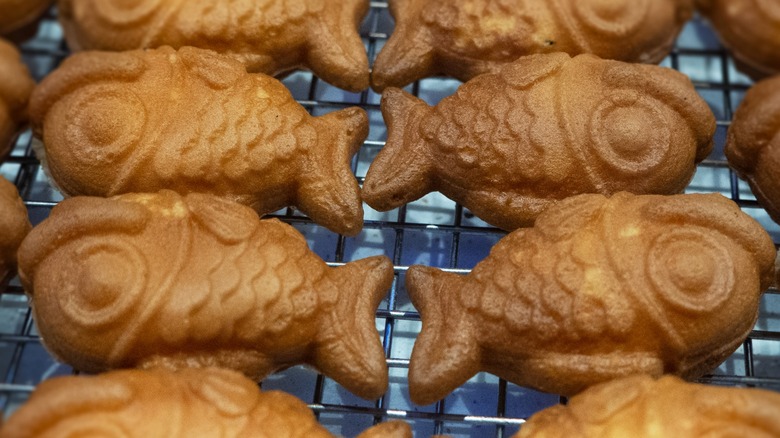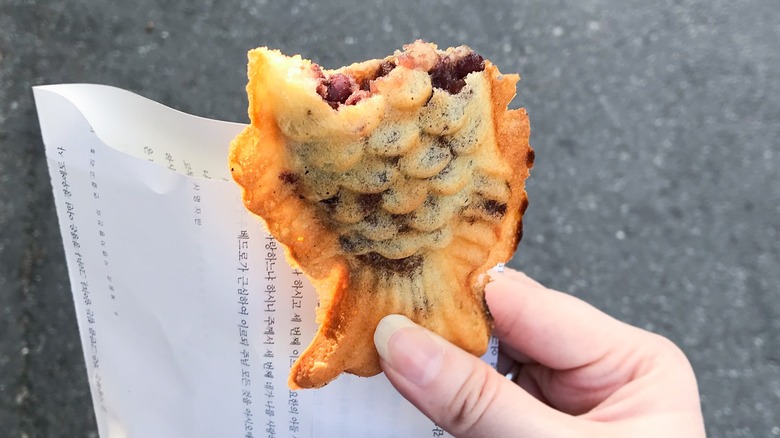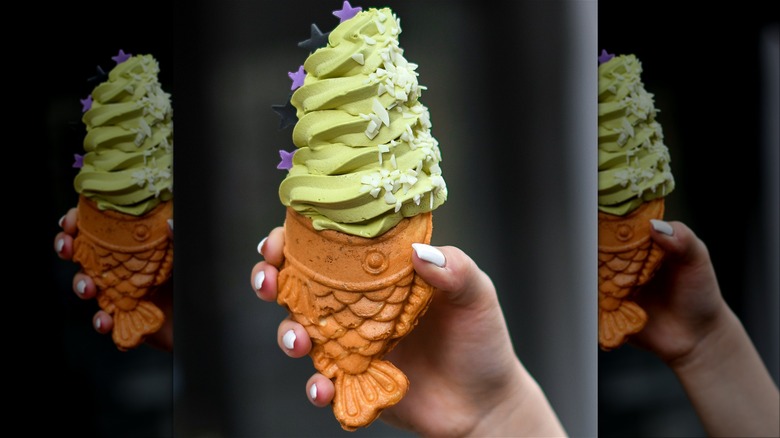Carp Bread Is The Korean Street Food That's Much Sweeter Than It Sounds
Nestled in Eastern Asia on the southern half of the Korean peninsula, South Korea is a hub of vibrant culture, and the country's food is a major part of that. Several pop culture influences — like 2012's smash hit song "Gangnam Style" and 2019's Oscar-winning film "Parasite" — have turned the rest of the globe's eyes on the small country, so it's only natural that an interest in Korean dining would follow suit.
In recent years, one particular palm-sized, fish-shaped Korean pastry made a splash on Instagram feeds across the United States. First hitting areas like Los Angeles and New York, these fishy pastries are actually a little deceiving, because they don't really contain any fish at all. Carp bread — which is the English translation of "bungeo-ppang" — is a sweet, soft, pancake-like treat that's stuffed with various fillings, most commonly sweet red bean paste.
Even though carp bread is just now taking the spotlight in the U.S., it was actually introduced to the States well over 20 years ago. But for Koreans, this is a snack that dates all the way back to the 1930s, making it one of the most popular and well-known desserts in South Korea.
The evolution of carp bread
You may have noticed that Korean carp bread bears an uncanny resemblance to Japanese taiyaki, and that's because it's essentially the same thing (give or take a few minor differences such as size and the type of fish depicted). As the stories go, a Japanese marketplace seller was having difficulty selling his imagawayaki — round pancakes stuffed with red bean paste — due to competition in the market.
In 1909, he came up with the idea of making his imagawayaki shaped like a sea bream, which is an expensive fish symbolizing good luck and fortune in Japan. Creating the imagawayaki in this shape allowed people of lesser means to enjoy sea bream in a way, which was a genius business move on the seller's behalf. In fact, his taiyaki shop is still up and running to this day.
The Japanese colonial period began a year later in 1910, and Korea was taken under Japan's rule. With Japan came taiyaki, and the Koreans started making their own version of the bread shaped like a carp instead of a sea bream. They called it bungeo-ppang. Over the next few decades, bungeo-ppang became a popular Korean street food, often sold by vendors with a filling of hot, red beans during winter festivals and markets as a way to warm up from the cold.
Carp bread in modern times
Nowadays, carp bread has become an iconic and nostalgic food in Korea, similar to how fair foods such as funnel cake are seen in the U.S. In fact, K-Pop Life reported that BTS member Jin made headlines in November 2023 when he gave a warm-hearted shout-out to the food in a video message for fans, stating that he hoped others could keep warm with the treat this winter. It's a reminder of childhood and simpler times for Koreans, but you can now catch it being made with a vast array of variations on fillings — and in many different places.
Nutella, custard, cream, and even ice cream have all become popular choices inside carp bread in addition to the traditional sweet red bean paste. In Los Angeles, carp bread — which has become less and less distinguishable from Japanese taiyaki to the point that the two breads' names are even used interchangeably — has earned the title of a snacking staple.
Traditional red bean-style options are now sold by food trucks and stands throughout the city and grocery stores even sell pre-packaged bungeo-ppang ice cream sandwiches called Samanco. Koreatown dessert cafes like Mumu Bakery also offer unique savory twists on taiyaki, including cheese and pizza flavors, as well as a seed-stuffed version. Some locations even load ice cream into the opening of the fish's mouth, allowing it to become the perfect fish-shaped ice cream cone vessel.


